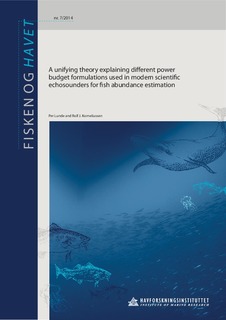| dc.description.abstract | Acoustic methods used in fish abundance estimation constitute a key part of the analytic assessment that makes the basis for fisheries research and international regulations of marine resources. The methods rely on power budget equations and calibrated systems. Different instrument specific formulations of power budget equations and calibration factors are used in modern scientific echosounder and sonar systems, such as the Simrad EK500 and the more recent Simrad EK60, ES60, ME70 and MS70 systems. These are instruments extensively used internationally for such applications, over the last decade or more. However, the lack of sufficient documentation in prior literature, on the actual power budget equations and calibration factors employed in these instruments, and their relationships to the traditional theory of fish abundance measurement, has caused some uncertainty and confusion among users. Control with systematic errors and drift demands the functional relationship of the abundance measurement to be fully known in terms of the electrical and acoustical parameters of the system used. The paper presents a unifying theory which seems to explain the different (instrument specific) power budget equation formulations and calibration factors employed in the mentioned echosounder and sonar systems, how they are related, and their relationship to the traditional and generic (instrument independent) theory of fish abundance measurement. Inconsistencies in prior literature are explained and corrected. Prior literature on the traditional theory is extended to provide more complete power budget equations for fish abundance estimation and species identification, by accounting for electrical termination, representation of echo integration, and the full range of electrical and acoustical echosounder parameters. These extensions apply both to the instrument specific and the generic instrument independent formulations. The expressions derived here provide a consistent and relatively complete theoretical basis for improved understanding and control in use of conventional methods and instruments for fish abundance measurement and species identification employed today. | nb_NO |
